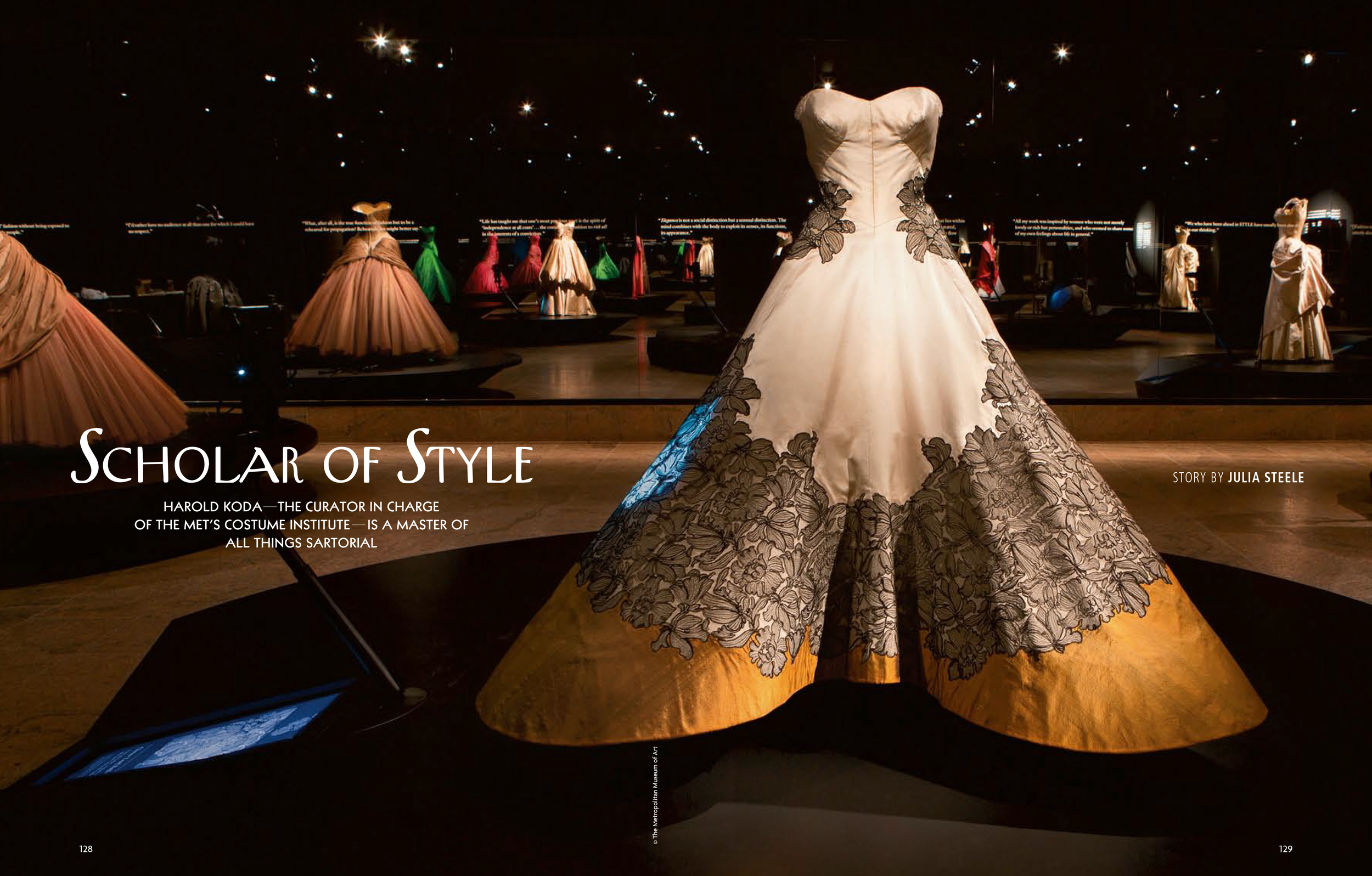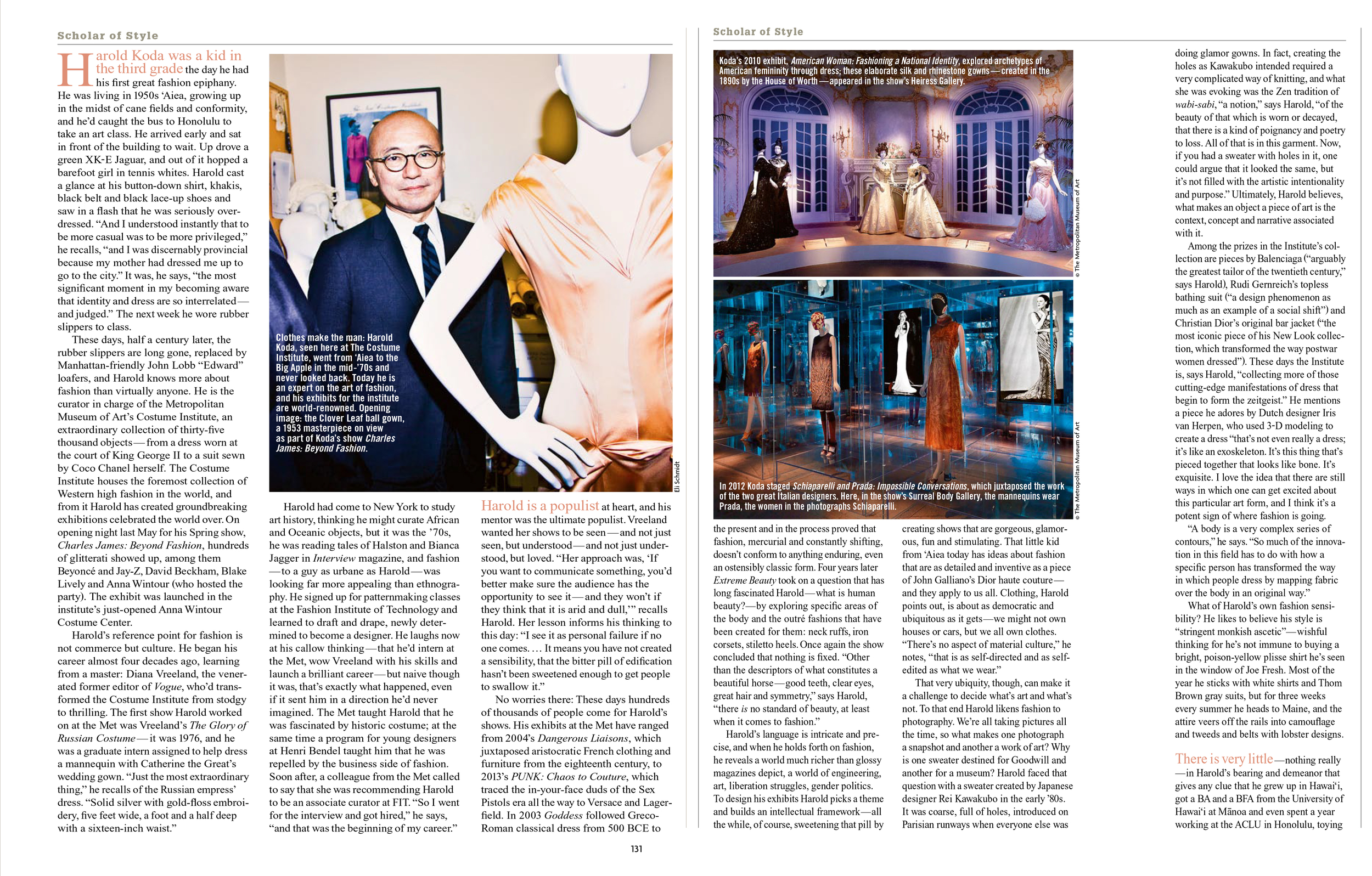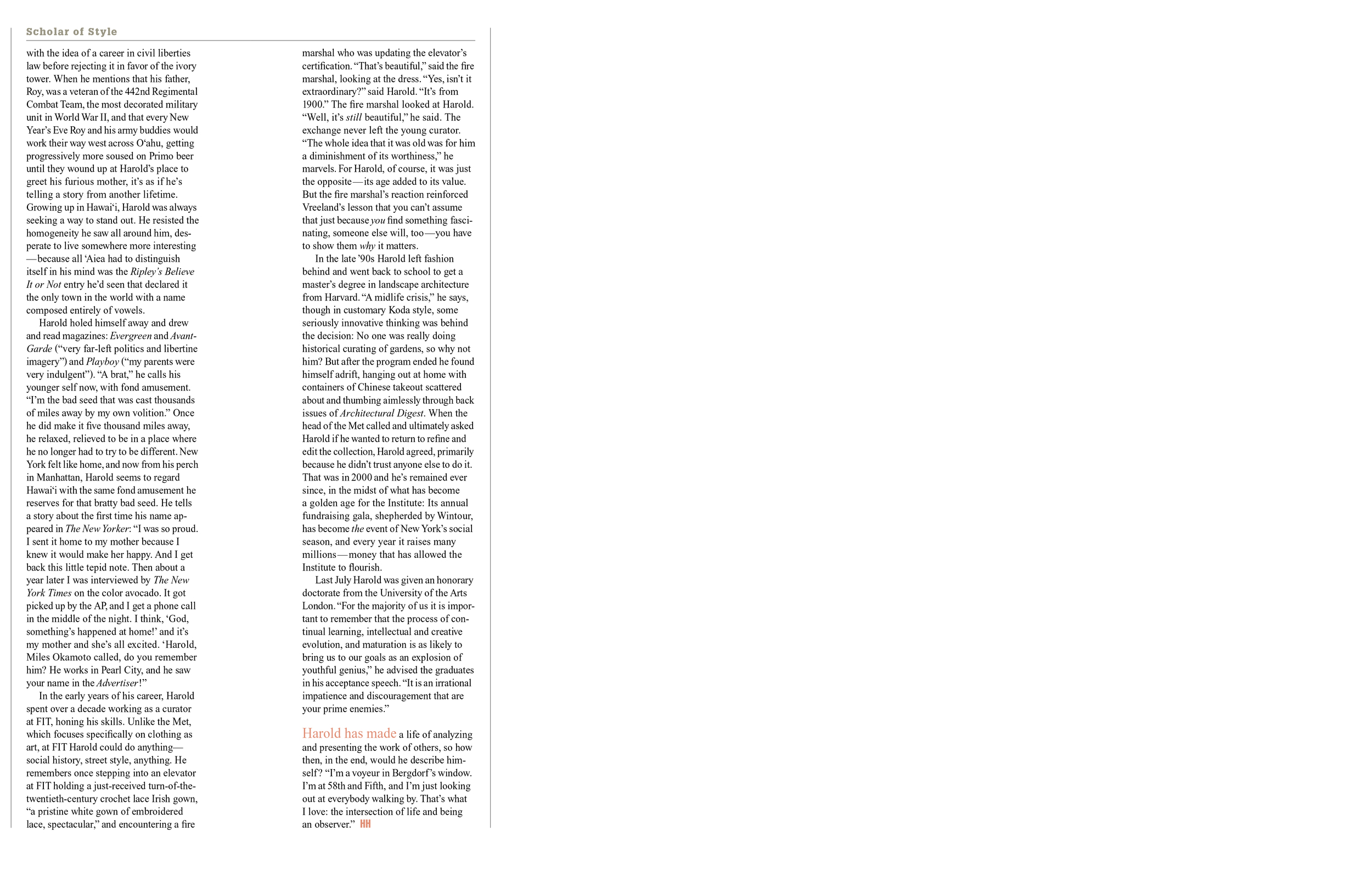Harold Koda was a kid in the third grade the day he had his first great fashion epiphany. He was living in 1950s ‘Aiea, growing up in the midst of cane fields and conformity, and he’d caught the bus to Honolulu to take an art class. He arrived early and sat in front of the building to wait. Up drove a green XK-E Jaguar, and out of it hopped a barefoot girl in tennis whites. Harold cast a glance at his button-down shirt, khakis, black belt and black lace-up shoes and saw in a flash that he was seriously overdressed. “And I understood instantly that to be more casual was to be more privileged,” he recalls, “and I was discernably provincial because my mother had dressed me up to go to the city.” It was, he says, “the most significant moment in my becoming aware that identity and dress are so interrelated—and judged.” The next week he wore rubber slippers to class.
These days, half a century later, the rubber slippers are long gone, replaced by Manhattan-friendly John Lobb “Edward” loafers, and Harold knows more about fashion than virtually anyone. He is the curator in charge of the Metropolitan Museum of Art’s Costume Institute, an extraordinary collection of thirty-five thousand objects—from a dress worn at the court of King George II to a suit sewn by Coco Chanel herself. The Costume Institute houses the foremost collection of Western high fashion in the world, and from it Harold has created groundbreaking exhibitions celebrated the world over. On opening night last May for his Spring show, Charles James: Beyond Fashion, hundreds of glitterati showed up, among them Beyoncé and Jay-Z, David Beckham, Blake Lively and Anna Wintour (who hosted the party). The exhibit was launched in the Institute’s just-opened Anna Wintour Costume Center.
Harold’s reference point for fashion is not commerce but culture. He began his career almost four decades ago, learning from a master: Diana Vreeland, the venerated former editor of Vogue, who’d transformed the Costume Institute from stodgy to thrilling. The first show Harold worked on at the Met was Vreeland’s The Glory of Russian Costume—it was 1976, and he was a graduate intern assigned to help dress a mannequin with Catherine the Great’s wedding gown. “Just the most extraordinary thing,” he recalls of the Russian empress’s dress. “Solid silver with gold-floss embroidery, five feet wide, a foot and a half deep with a sixteen-inch waist.”
Harold had come to New York to study art history, thinking he might curate African and Oceanic objects, but it was the ’70s, he was reading tales of Halston and Bianca Jagger in Interview magazine, and fashion—to a guy as urbane as Harold—was looking far more appealing than ethnography. He signed up for patternmaking classes at the Fashion Institute of Technology and learned to draft and drape, newly determined to become a designer. He laughs now at his callow thinking—that he’d intern at the Met, wow Vreeland with his skills and launch a brilliant career—but naive though it was, that’s exactly what happened, even if it sent him in a direction he’d never imagined. The Met taught Harold that he was fascinated by historic costume; at the same time a program for young designers at Henri Bendel taught him that he was repelled by the business side of fashion. Soon after, a colleague from the Met called to say that she was recommending Harold to be an associate curator at FIT. “So I went for the interview and got hired,” he says, “and that was the beginning of my career.”
Harold is a populist at heart, and his mentor was the ultimate populist. Vreeland wanted her shows to be seen—and not just seen, but understood—and not just understood, but loved. “Her approach was, ‘If you want to communicate something, you’d better make sure the audience has the opportunity to see it—and they won’t if they think that it is arid and dull,’” recalls Harold. Her lesson informs his thinking to this day: “I see it as personal failure if no one comes. … It means you have not created a sensibility, that the bitter pill of edification hasn’t been sweetened enough to get people to swallow it.”
No worries there: These days hundreds of thousands of people come for Harold’s shows. His exhibits at the Met have ranged from 2004’s Dangerous Liaisons, which juxtaposed aristocratic French clothing and furniture from the eighteenth century, to 2013’s PUNK: Chaos to Couture, which traced the in-your-face duds of the Sex Pistols era all the way to Versace and Lagerfield. In 2003 Goddess followed Greco-Roman dress from 500 BCE to the present and in the process proved that fashion, mercurial and constantly shifting, doesn’t conform to anything enduring, even an ostensibly classic form. Four years later Extreme Beauty took on a question that has long fascinated Harold—what is human beauty?—by exploring specific areas of the body and the outré fashions that have been created for them: neck ruffs, iron corsets, stiletto heels. Once again the show concluded that nothing is fixed. “Other than the descriptors of what constitutes a beautiful horse—good teeth, clear eyes, great hair and symmetry,” says Harold, “there is no standard of beauty, at least when it comes to fashion.”
Harold’s language is intricate and precise, and when he holds forth on fashion, he reveals a world much richer than glossy magazines depict, a world of engineering, art, liberation struggles, gender politics. To design his exhibits Harold picks a theme and builds an intellectual framework—all the while, of course, sweetening that pill by creating shows that are gorgeous, glamorous, fun and stimulating. That little kid from ‘Aiea today has ideas about fashion that are as detailed and inventive as a piece of John Galliano’s Dior haute couture—and they apply to us all. Clothing, Harold points out, is about as democratic and ubiquitous as it gets—we might not own houses or cars, but we all own clothes. “There’s no aspect of material culture,” he notes, “that is as self-directed and as self-edited as what we wear.”
That very ubiquity, though, can make it a challenge to decide what’s art and what’s not. To that end Harold likens fashion to photography. We’re all taking pictures all the time, so what makes one photograph a snapshot and another a work of art? Why is one sweater destined for Goodwill and another for a museum? Harold faced that question with a sweater created by Japanese designer Rei Kawakubo in the early ’80s. It was coarse, full of holes, introduced on Parisian runways when everyone else was doing glamor gowns. In fact, creating the holes as Kawakubo intended required a very complicated way of knitting, and what she was evoking was the Zen tradition of wabi-sabi, “a notion,” says Harold, “of the beauty of that which is worn or decayed, that there is a kind of poignancy and poetry to loss. All of that is in this garment. Now, if you had a sweater with holes in it, one could argue that it looked the same, but it’s not filled with the artistic intentionality and purpose.” Ultimately, Harold believes, what makes an object a piece of art is the context, concept and narrative associated it.
Among the prizes in the Institute’s collection are pieces by Balenciaga (“arguably the greatest tailor of the twentieth century,” says Harold), Rudi Gernreich’s topless bathing suit (“a design phenomenon as much as an example of a social shift”) and Christian Dior’s original bar jacket (“the most iconic piece of his New Look collection, which transformed the way postwar women dressed”). These days the Institute is, says Harold, “collecting more of those cutting-edge manifestations of dress that begin to form the zeitgeist.” He mentions a piece he adores by Dutch designer Iris van Herpen, who used 3-D modeling to create a dress “that’s not even really a dress; it’s like an exoskeleton. It’s this thing that’s pieced together that looks like bone. It’s exquisite. I love the idea that there are still ways in which one can get excited about this particular art form, and I think it’s a potent sign of where fashion is going.
“A body is a very complex series of contours,” he says. “So much of the innovation in this field has to do with how a specific person has transformed the way in which people dress by mapping fabric over the body in an original way.”
What of Harold’s own fashion sensibility? He likes to believe his style is “stringent monkish ascetic”—wishful thinking for he’s not immune to buying a bright, poison-yellow plisse shirt he’s seen in the window of Joe Fresh. Most of the year he sticks with white shirts and Thom Brown gray suits, but for three weeks every summer he heads to Maine, and the attire veers off the rails into camouflage and tweeds and belts with lobster designs.
There is very little—nothing really—in Harold’s bearing and demeanor that gives any clue that he grew up in Hawai‘i, got a BA and a BFA from the University of Hawai‘i at Mänoa and even spent a year working at the ACLU in Honolulu, toying with the idea of a career in civil liberties law before rejecting it in favor of the ivory tower. When he mentions that his father, Roy, was a veteran of the 442nd Regimental Combat Team, the most decorated military unit in World War II, and that every New Year’s Eve Roy and his army buddies would work their way west across O‘ahu, getting progressively more soused on Primo beer until they wound up at Harold’s place to greet his furious mother, it’s as if he’s telling a story from another lifetime. Growing up in Hawai‘i, Harold was always seeking a way to stand out. He resisted the homogeneity he saw all around him, desperate to live somewhere more interesting—because all ‘Aiea had to distinguish itself in his mind was the Ripley’s Believe It or Not entry he’d seen that declared it the only town in the world with a name composed entirely of vowels.
Harold holed himself away and drew and read magazines: Evergreen and Avant-Garde (“very far-left politics and libertine imagery”) and Playboy (“my parents were very indulgent”). “A brat,” he calls his younger self now, with fond amusement. “I’m the bad seed that was cast thousands of miles away by my own volition.” Once he did make it five thousand miles away, he relaxed, relieved to be in a place where he no longer had to try to be different. New York felt like home, and now from his perch in Manhattan, Harold seems to regard Hawai‘i with the same fond amusement he reserves for that bratty bad seed. He tells a story about the first time his name appeared in The New Yorker: “I was so proud. I sent it home to my mother because I knew it would make her happy. And I get back this little tepid note. Then about a year later I was interviewed by The New York Times on the color avocado. It got picked up by the AP, and I get a phone call in the middle of the night. I think, ‘God, something’s happened at home!’ and it’s my mother and she’s all excited. ‘Harold, Miles Okamoto called, do you remember him? He works in Pearl City, and he saw your name in the Advertiser!”
In the early years of his career, Harold spent over a decade working as a curator at FIT, honing his skills. Unlike the Met, which focuses specifically on clothing as art, at FIT Harold could do anything—social history, street style, anything. He remembers once stepping into an elevator at FIT holding a just-received turn-of-the-twentieth-century crochet lace Irish gown, “a pristine white gown of embroidered lace, spectacular,” and encountering a fire marshal who was updating the elevator’s certification. “That’s beautiful,” said the fire marshal, looking at the dress. “Yes, isn’t it extraordinary?” said Harold. “It’s from 1900.” The fire marshal looked at Harold. “Well, it’s still beautiful,” he said. The exchange never left the young curator. “The whole idea that it was old was for him a diminishment of its worthiness,” he marvels. For Harold, of course, it was just the opposite—its age added to its value. But the fire marshal’s reaction reinforced Vreeland’s lesson that you can’t assume that just because you find something fascinating, someone else will, too—you have to show them why it matters.
In the late ’90s Harold left fashion behind and went back to school to get a master’s degree in landscape architecture from Harvard. “A midlife crisis,” he says, though in customary Koda style, some seriously innovative thinking was behind the decision: No one was really doing historical curating of gardens, so why not him? But after the program ended he found himself adrift, hanging out at home with containers of Chinese takeout scattered about and thumbing aimlessly through back issues of Architectural Digest. When the head of the Met called and ultimately asked Harold if he wanted to return to refine and edit the collection, Harold agreed, primarily because he didn’t trust anyone else to do it. That was in 2000 and he’s remained ever since, in the midst of what has become a golden age for the Institute: Its annual fundraising gala, shepherded by Wintour, has become the event of New York’s social season, and every year it raises many millions—money that has allowed the Institute to flourish.
Last July Harold was given an honorary doctorate from the University of the Arts London. “For the majority of us it is important to remember that the process of continual learning, intellectual and creative evolution, and maturation is as likely to bring us to our goals as an explosion of youthful genius,” he advised the graduates in his acceptance speech. “It is an irrational impatience and discouragement that are your prime enemies.”
Harold has made a life of analyzing and presenting the work of others, so how then, in the end, would he describe himself? “I’m a voyeur in Bergdorf’s window. I’m at 58th and Fifth, and I’m just looking out at everybody walking by. That’s what I love: the intersection of life and being an observer.”


